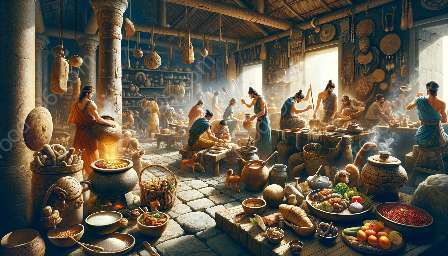The Aztecs were renowned for their rich and diverse culinary traditions, which played a significant role in shaping the global food culture. Their cuisine utilized a wide variety of unique ingredients and cooking techniques, and it continues to influence culinary arts in modern times.
Ingredients and Staple Foods
Maize: Maize, or corn, was the primary staple of the Aztec diet and held immense cultural and religious significance. It was used to make corn tortillas, tamales, and a fermented beverage called chicha. The Aztecs also prepared a porridge known as atole from maize.
Beans: Various types of beans, including black beans and kidney beans, were essential protein sources in Aztec cuisine. They were often combined with maize to create nutritious and hearty dishes.
Chilies: Aztec cooking incorporated a wide range of chili peppers, adding complex flavors and spiciness to their dishes. Chilies were used fresh, dried, and in various forms of sauces and pastes.
Chocolate: The Aztecs were among the first to cultivate and consume cacao beans, which were used to create a frothy and bitter beverage called xocolatl. Cacao beans also held ritualistic and ceremonial significance.
Avocado: The Aztecs cherished avocado and used it in various preparations, such as guacamole and as a filling for tamales.
Tomatoes: Though not widely known in Europe until later, the Aztecs were using tomatoes in their cooking, including in sauces and stews.
Cooking Techniques and Methods
The Aztecs employed various cooking techniques to transform their staple ingredients into flavorful and nourishing meals. Some of the key methods included:
- Grinding maize into dough to make tortillas and tamales
- Boiling, stewing, and steaming beans and meats to create soups and stews
- Roasting and grinding cacao beans to produce chocolate beverages
- Using metates and manos, traditional grinding tools, to process ingredients
Cultural Significance
Aztec cuisine was deeply intertwined with their cultural and religious practices. Food held symbolic importance in religious ceremonies, feasts, and daily life. The Aztecs considered cooking and eating an act that connected them with the divine and with their ancestors.
Furthermore, the roles of individuals in food preparation and consumption were defined by societal structures, honoring the labor that went into cultivation, harvest, and cooking.
Influence on Modern Cuisine
The culinary traditions of the Aztecs have left a lasting impact on modern Mexican and global cuisine. Elements of Aztec cuisine, such as tortillas, tamales, and the use of chocolate, continue to be celebrated and incorporated into contemporary dishes and culinary arts.
Moreover, the cultural significance of certain ingredients, such as maize and chilies, extends beyond the culinary realm, shaping the identities and customs of various communities.

